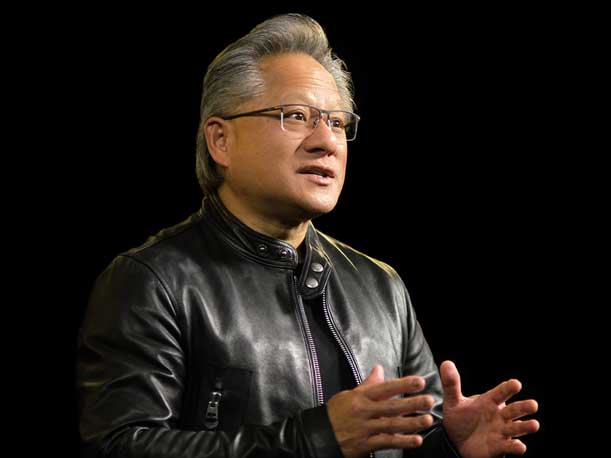Nvidia Revenue Doubles Over A Year Due To Generative AI Demand
Jensen Huang, Nvidia’s co-founder and CEO, says high demand for the AI chip giant’s most powerful GPUs is recognition that many companies are moving from data centers powered by CPUs to ones that are accelerated by GPUs, which can bring substantial boosts in performance and efficiency.

Nvidia’s revenue doubled over a year in the second quarter, mainly due to strong demand for the chip designer’s H100 and A100 data center GPUs that was driven by generative AI development.
The Santa Clara, Calif.-based AI chip giant Wednesday reported record revenue of $13.5 billion for the second quarter of its 2024 fiscal year, which ended July 30. That is essentially double, or a 101 percent increase, from what the company made during the same period in the previous fiscal year. It was also an 88 percent increase from the previous quarter.
[Related: Nvidia CEO Explains How AI Chips Could Save Future Data Centers Lots Of Money]
Jensen Huang, Nvidia’s co-founder and CEO, said the high demand for its most powerful GPUs is recognition that many companies are moving from data centers powered by CPUs to ones that are accelerated by GPUs, which can bring substantial boosts in performance and efficiency.
“The easiest way to think about the demand is the world is transitioning from general-purpose computing to accelerated computing,” he said on Nvidia’s earnings call.
“The best way for companies to increase their throughput, improve their energy efficiency, improve their cost efficiency is to divert their capital budget to accelerated computing and generative AI. Because by doing that, you’re going to offload so much workload off of the CPUs that the available CPUs is in your data center will get boosted,” Huang added.
The record revenue allowed Nvidia to beat Wall Street’s expectations by $2.4 billion. The company’s earnings per share of $2.70 surpassed analyst estimates too, by 61 cents.
The chip designer said it expects revenue to reach $16 billion, plus or minus 2 percent, in the third quarter. While this would amount to much slower sequential growth, it would still mark a roughly 169 percent increase from the same period in the previous year.
Nvidia’s stock price was up more than 7 percent in after-hours trading.
Nvidia’s Data Center Business Grew 171 Percent Year Over Year
The company’s data center business drove most of the growth in the second quarter, with revenue increasing 171 percent year over year and 141 percent from the previous three months to $10.3 billion.
Colette Kress, Nvidia’s CFO, said the primary growth drivers for the business were cloud service providers and large consumer internet companies buying servers based on the company’s HGX platform, which comes with either its flagship H100s or the previous-generation A100s.
These customers include Amazon Web Services, Google Cloud, Facebook parent company Meta, Microsoft Azure and Oracle Cloud, and they’re using Nvidia’s fastest GPU systems to develop new applications using generative AI capabilities, including Large Language Models, according to Kress.
“There is tremendous demand for Nvidia accelerated computing and AI platform, and our supply partners have been exceptional in ramping capacity to support our needs,” she said.
In addressing supply constraints for the company’s popular H100, Kress added that Nvidia has “developed and qualified additional capacities and suppliers for key steps in the manufacturing process, such as CoWoS packaging,” which is key to the GPU’s fabrication.
“Our supply over the next several quarters will continue to ramp as we lower cycle time and work with our supply partners to add capacity,” she said.
Kress added that Nvidia’s recently unveiled L40S GPU, a universal accelerator for both AI and graphical workloads, “will help address the growing demand for many types of workloads from cloud to enterprise.”
The ongoing craze around generative AI also created high demand for the company’s InfiniBand networking products, which caused networking revenue to almost double.
Beyond GPUs, networking products and systems, Nvidia is beginning to build a substantial business around software. Kress said the company is “probably” making “hundreds of millions of dollars annually” from commercial software products, including Nvidia AI Enterprise, which the company is including with the purchase of an H100 PCIe card for standard servers.
How Nvidia’s Other Businesses Performed
Nvidia’s gaming revenue rebounded in the second quarter, growing 22 percent year over year to nearly $2.4 billion after suffering from a slump in demand for gaming GPUs in the previous several months.
Kress said the growth was due to demand for the company’s GeForce 40 Series GPUs “following the normalization of channel inventory levels.”
Revenue for professional visualization, on the other hand, declined 24 percent year over year to $379 million, which reflected “lower sell-in to partners” after inventory levels normalized. At the same time, Kress said the business grew 28 percent sequentially, mainly “due to stronger enterprise workstation demand and the ramp of Nvidia RTX products based on the Ada Lovelace architecture.”
The automotive business saw revenue grow 15 percent year over year to $253 million. This was the result of higher sales of Nvidia’s self-driving platforms. However, automotive revenue dropped 15 percent from the previous quarter due to “lower overall auto demand, particularly in China.”
Nvidia provided no commentary for the first time around its OEM and other revenue, which includes the company’s Cryptocurrency Mining Processors. Revenue for this category fell 53 percent year over year and 14 percent from the previous quarter to $66 million.